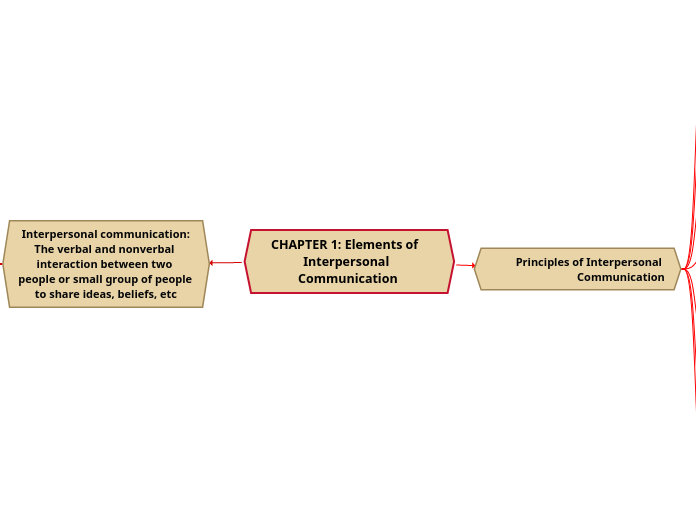CHAPTER 1: Elements of Interpersonal Communication
Principles of Interpersonal Communication
Transactional Process
It is an ever-changing, circular process; you’re changing, the people you communicate with are changing and your environment is changing
Purposeful
To learn
To relate
To influence
To play
To help
Ambiguous
An ambiguous message is a message that can be interpreted as having more than one meaning.
Sometimes ambiguity occurs because people use words that can be interpreted differently.
Relationships may be symmetrical or complementary
Symmetrical relationship: the two individuals mirror each other’s behavior
Complementary relationship: the two individuals engage in different behaviors
The relationship is one of equality.
Refer to Content & Relationship
Messages may refer to the real world (content messages) for example to the events and objects you see before you
Messages may also refer to the relationship between the people communicating (relationship messages)
Series of Punctuated Events
Communication events are continuous transactions. There is no clear-cut beginning and no clear-cut ending
Punctuation is referred to as the tendency to divide communication transactions into sequences of stimuli and responses
Inevitable, Irreversible and Unrepeatable
Interpersonal communication cannot be prevented (is inevitable), cannot be reversed (is irreversible) and cannot be repeated (is unrepeatable)
Interpersonal communication:
The verbal and nonverbal interaction between two people or small group of people to share ideas, beliefs, etc
Source-receiver
Each individual performs source functions (formulates and sends messages) and also performs receiver functions (perceives and comprehends messages).
Your ability to communicate effectively (as source/receiver) is your interpersonal competence)
Encoding-Decoding
Encoding: The act of producing message (speakers & writer as endocers)
Decoding: The act of understanding messages (listeners & readers as decoders)
Messages
The signals that serve as stimuli for receiver and received by one of our sense (auditory, visual, tactile, olfactory, gustatory
by gesture and touch as well as by words and sentences
Intentional or inintentional
Metamessages, feedback messages, feedforward messages
Channel
Subtopic
Face-to-face
Noise
Anything that distorts a message, or prevents the receiver from receiving the messages
Type of noise:-
Physical noise: External interference of both speaker and sender
Physiological noise: Created by barriers within the sender or receiver
Psychological noise: Mental interference in speaker or listener
Semantic noise: Interference that occurs when the speaker and listener have different meaning systems
Context
Physical dimension: Is the tangible or concrete environment in which communication takes place
Temporal dimension: The time of day and where a particular message fits into the sequence of communication events
Temporal dimension: The time of day and where a particular message fits into the sequence of communication events
Temporal dimension: The time of day and where a particular message fits into the sequence of communication events
Ethics
Communication choices need to be guided by ethical considerations as well as by concerns with effectiveness and satisfaction.
Each communication act has a moral dimension, a rightness or wrongness
Mindfulness
A state of mental awareness
Being conscious of your reasons for thinking or communicating in a particular way
Become aware of your choices
